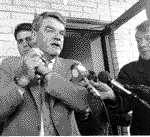 Above: after the prison sentence, Kujau set up a Gallery of Fakes, and offered a service authenticating his own or Hitler's artworks | For sale: Signed lithographs by Konrad Kujau, the most famous forger in history Send us your shipping address and we will get back to you | |||||||||||
 IN
THE early 1980s master-forger Konrad
Kujau above, pulled off a
multi-million dollar stunt which went down in
history -- he sold seventy-two handwritten
Adolf Hitler diaries, which he had
laboriously faked, to leading magazines and
newspapers around the world including
Newsweek, The Sunday Times, and
Stern in Germany. Among
the items he sold were also "sketches and
paintings by Hitler", which he had also forged.
He was a master craftsman, and a competent
draughtsman too for that matter. It
was David Irving who exposed the fakery at
Stern's press conference announcing their
scoop in April 1983. After
serving his prison sentence for the forgery,
Kujau earned a living as an artist, and painted
forty ironic lithographs caricaturing the top
Nazis. Most have messages and captions in
"Hitler's handwriting". The
lithos are uniformly 58.5cm high by 41cm wide;
one image, No.60, is an oil painting. All are
professionally mounted and signed by
Kujau. Fast
forward to 1992. On
October 28, 1992 David Irving was arrested by
the Royal Canadian Mounted Police in Victoria,
British
Columbia,
after
receiving an award from Canada's George Orwell
Society; he had just delivered a lecture on
freedom of speech to an audience in Victoria, on
Vancouver
Island.
Ordered
by a mainland judge to leave Canada by midnight
on November 1, 1992 under a Voluntary Departure
agreement, he gathered up his belongings with
the assistance of an American stranger,
Brian
Fisher, an entrepreneur who had offered to
drive him back to the island to pick up his
belongings.
In
return, Fisher unexpectedly asked Mr Irving to
do him a favour: to countersign the forty
original lithographs he had bought from Kujau.
Each
was signed by the artist, Kujau, and Fisher
reasoned that by adding the signature of Mr
Irving, the historian who had exposed Kujau's
historic fraud at Der Stern's press conference
in 1983, he would increase their value.
No
problem: they drove over in Fisher's blue
Lincoln Continental, Irving signed the lithos,
phoned friends in Ontario (by Pacific Bell) to
organise a huge going-away festival, then drove
back into Canada two or three hours later and
flew east to Toronto. He
had thus inadvertently already complied with the
strict requirement that he leave Canadian soil
by midnight on November 1 (the law allows a
return after that at any time). When
that date came, Canadian Immigration officers
prevented him from leaving, phoning ahead to the
US border officials and asking them to turn him
back on a pretext. The unsuspecting US official
complied, and Mr Irving was trapped. A
two-week trial on Canadian soil ensued, in which
he was accused of violating the Voluntary
Departure agreement. Since
then Mr Irving has been refused permission to
re-enter Canada, and his expulsion has been used
by countries around the world to justify his
exclusion from them too. Konrad
Kujau the artist died in September,
2000.
Brian Fisher died in 2008, and his estate is
offering the forty historic double-signed lithos
for sale. The
complete set can
be viewed here
[Gallery],
and the originals will be on display at the
MAX Militaria Show in Monroeville,
Pennsylvania, on the weekend of October 1-3,
2009. Each bears the authentic autographs of
Konrad Kujau the forger, and of David Irving,
the British historian who unmasked him.
| ||||||||||||



